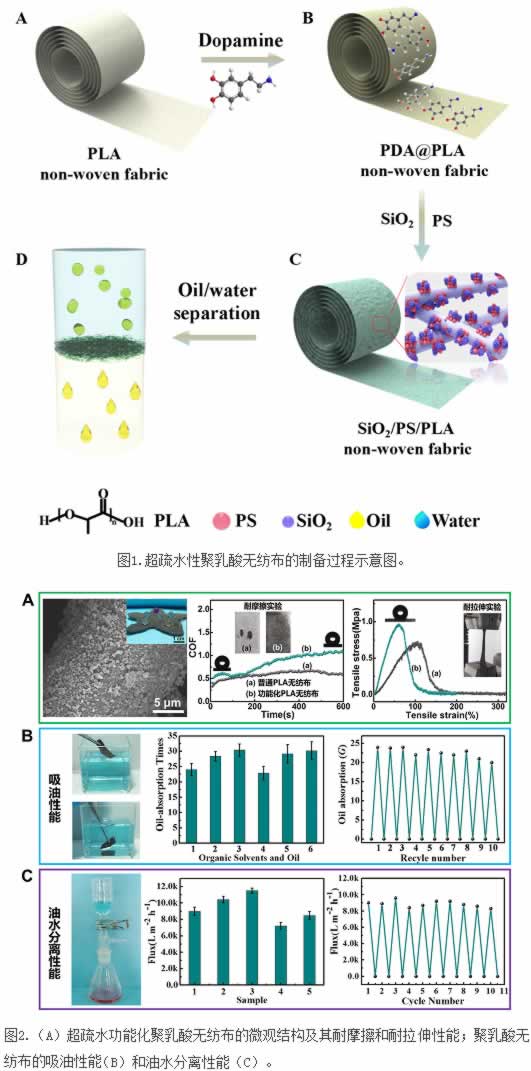In recent years, frequent oil spills have caused serious environmental pollution problems, which have brought serious impacts on the sustainable development of the economy and society and people's production and life. In order to maintain a good ecological environment and human health and protect limited water resources, it is particularly important to effectively separate the oily sewage bodies. Therefore, new materials with oil-water separation have become one of the focuses of scientists. At present, the use of special infiltrating surfaces such as superhydrophobic surfaces, superhydrophilic surfaces, etc., for oil-water separation has become a hot topic of functional materials research. However, although there are currently many kinds of special infiltrating materials with good oil-water separation capabilities, most of their materials are mostly non-degradable or hardly degradable polymer materials, especially lipophilic oil-water separation materials due to their lipophilicity. The characteristics of this material make it easy to be polluted in the process of treating oily wastewater. After use, it often produces a large amount of indiscriminately polluted garbage and waste. It is not only easy to cause secondary pollution to the environment, but also has a high overall cost of post-processing. One of the important factors restricting the practical application of oil-water separation materials. The construction of environment-friendly oil-water separation materials has become an important issue to be solved. Recently, the Intelligent Polymer Materials Group of the Ningbo Institute of Materials Technology and Engineering, Chinese Academy of Sciences, has developed bio-compatibility and biodegradable bio-based polymer materials such as polylactic acid (PLA) non-woven fabric as the main raw material, and has been specially prepared for infiltration. Biodegradable environmentally friendly oil-water separation material. Researchers used polydopamine as a “functional coating†for surface treatment of materials to achieve simple and effective modification of the fiber surface in polylactic acid nonwovens, and to use functional groups such as hydroxyl and imine groups contained in polydopamine as further functionalization. "Bridge", nanoscale silica particles (SiO2) and micron-sized polystyrene microspheres are loaded on the surface of polylactic acid fibers, thereby subtly constructing a polylactic acid nonwoven having a micro-nanometer multi-stage assembly structure Composite material (Figure 1). The researchers found that this new type of polylactic acid nonwoven material not only has a high surface roughness, but also achieves a superhydrophobic state when water droplets contact the surface. More importantly, the stability of the superhydrophobic surface of the nonwoven fabric is very high. Even after repeated friction or tensile deformation, the nonwoven fabric retained a stable microstructure and superhydrophobic surface properties (Fig. 2A). Taking advantage of this advantage, the researchers used it for oil absorption experiments and separated oil-water mixtures. As a result, it was found that this modified polylactic acid non-woven fabric can not only rapidly adsorb large amounts of organic solvents, but also perform gravitational force on the oil-water mixture. Rapid and effective separation, and high repetition rate, the separation effect is very stable (Figure 2B, 2C). The research work provides new ideas for the effective separation of waste water and the post-treatment of contaminated separation materials, and has important guiding significance in the development of green and environmentally friendly oily wastewater separation materials. At present, related work has been published in the Journal of the American Chemical Society ACS Applied Materials & Interfaces (2017, 9, 5968-5973). This research was supported by the National Natural Science Foundation of China (51,603,216), the Frontier Science and Education Bureau of the Chinese Academy of Sciences (QYZDB-SSW-SLH036), the Zhejiang Provincial Research Project on the Application of Charity Technologies (2015C33031), the Youth Innovation Promotion Association of the Chinese Academy of Sciences (2017337, 2016268) and the Chinese Academy of Sciences Ocean. Funding for projects such as 2016Z01 and 2017K03 in the Open Project of the Key Laboratory of New Materials and Applied Technology.
Ultra Plantâ„¢ Grow Light offers One Chip Technology aimed to meet your indoor growing expectation such as improve plants' quality, increase yield, or better the margin, etc., all for helping you realize a higher return on your crops.
From Ultra Plantâ„¢ APP, you are able to schedule the growing process including photoperiod, brightness and spectral in advance. The lighting system will help you grow smarter, easier and better.
Uv Grow Light,Uv Light For Plants,Uv Lamp For Plants,Uv Grow Lights For Plants Feton Corporation , https://www.ultraplantled.com
Ultra Plantâ„¢ Grow Light is combined our advanced All-In-One technology with patented optical design and customized light full spectrum supported from our experienced LED engineers, plant specialists and other partners working on horticulture.
Ultra Plantâ„¢ is the most versatile horticultural grow lighting fixture for indoor plants with flexible full spectrum, brightness control and uniform, wider light distribution, suitable for top lighting of all types of crops. No matter it applies to anywhere for any crop, Ultra Plantâ„¢ can do perfect work for you.